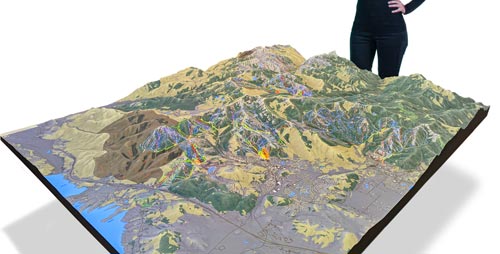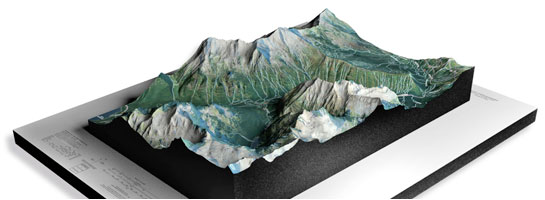Maps Glossary
WhiteClouds builds 3D Raised Relief Maps
Did you know we make
3D raised-relief maps

and
3D raised-relief maps

Ultraviolet Radiation
Ultraviolet radiation is a type of electromagnetic radiation that has a shorter wavelength than visible light but longer than X-rays. It is often abbreviated as UV radiation and is found naturally in sunlight. However, it can also be produced artificially by certain types of lamps. Ultraviolet radiation can cause skin damage and increase the risk of skin cancer, which is why it is important to wear sunscreen when spending time outdoors.
Unconformity
An unconformity is a boundary between two rock layers that represents a gap in the geologic record. This means that there is a period of time for which there is no rock layer present, which can make it difficult to determine the geologic history of an area. Unconformities can occur for a variety of reasons, such as erosion, non-deposition, or uplift and tilting of rock layers.
Undercurrent
An undercurrent is a current that flows beneath the surface of a body of water. Undercurrents can be caused by a variety of factors, such as differences in water density, water temperature, or the shape of the ocean floor. They can be dangerous for swimmers and boaters, as they can pull people or objects away from shore.
Underground Water
Underground water is water that is located beneath the surface of the Earth. It is often found in aquifers, which are underground layers of rock or sediment that are saturated with water. Underground water can be accessed through wells or springs and is an important source of drinking water for many people around the world. However, overuse of underground water can lead to depletion of aquifers and other environmental issues.
Uniformitarianism
Uniformitarianism is a geological principle that states that the processes that operate on the Earth’s surface today are the same processes that have been operating throughout Earth’s history. This principle implies that the geological features and processes we observe today can help us understand past events, such as the formation of mountains or the carving of canyons. The idea behind uniformitarianism is that the present is the key to the past, and that we can use modern-day observations to reconstruct past events. Uniformitarianism is a fundamental principle in geology and has been influential in shaping our understanding of the Earth’s history.
Unit Cell
In crystallography, a unit cell is the smallest repeating structure of a crystal lattice. It is a three-dimensional box that contains a group of atoms, ions, or molecules arranged in a specific pattern. The unit cell is used to describe the crystal structure of a material and can be used to predict its properties. The unit cell is characterized by its dimensions and the angles between its sides. By knowing the unit cell parameters, we can determine the symmetry and geometry of the crystal lattice.
Unweathered Rock
Unweathered rock is rock that has not been altered by weathering processes such as wind, water, or ice. It is the original, intact rock that has not been broken down into smaller pieces or chemically altered. Unweathered rock can be found at the surface of the Earth, but it is more common at depth, where it has been shielded from the effects of weathering. Unweathered rock is important in geology because it can provide clues about the history and composition of the Earth’s crust.
Updraft
An updraft is a vertical current of air that moves upward. Updrafts are commonly associated with convective weather systems, such as thunderstorms. They occur when warm air rises and cools, causing moisture in the air to condense and form clouds. Updrafts can be very strong and can cause turbulence in the atmosphere. They are important to pilots because they can affect the stability of aircraft and can cause sudden changes in altitude. Updrafts are also important in meteorology because they can help predict severe weather events such as thunderstorms and tornadoes.
Uplift
Uplift refers to the vertical movement of rock or sediment due to geological forces such as tectonic activity. This can result in the elevation of land or the exposure of deeper layers of rock. Uplift can occur over long periods of time, and can have a significant impact on the topography and geology of an area. One example of uplift is the gradual elevation of the Himalayas, which is the result of the collision of the Indian and Eurasian tectonic plates.
Uranium
Uranium is a naturally occurring radioactive element with the chemical symbol U. It is found in many rocks and minerals, and is the primary fuel used in nuclear power plants. Uranium has several isotopes, the most common of which is uranium-238. Uranium can also be used in nuclear weapons, and its mining and use can have significant environmental and health impacts.
Uranium-lead Dating
Uranium-lead dating is a radiometric dating method that uses the decay of uranium isotopes to determine the age of rocks and minerals. The method relies on the fact that uranium-238 decays into lead-206 at a known rate. By measuring the ratio of uranium-238 to lead-206 in a sample, scientists can calculate the age of the sample. Uranium-lead dating is one of the most reliable methods for dating rocks and minerals, and is commonly used to date the Earth’s oldest rocks.
USGS Topographic Map
A USGS Topographic Map is a detailed, accurate, and up-to-date map of a particular area, produced by the United States Geological Survey (USGS). These maps are designed to provide information about the terrain, elevation, and natural features of an area. They show contour lines, which indicate changes in elevation, as well as water bodies, vegetation, and other features that are important for land use and management. USGS Topographic Maps are widely used by a variety of professionals and individuals, including hikers, hunters, surveyors, engineers, and scientists. They are also used in planning and decision-making for land use and resource management.
USGS Historical Topographic Map
A USGS Historical Topographic Map is a type of map produced by the USGS that provides information about the historical changes in an area’s terrain, elevation, and natural features. These maps show changes in land use, vegetation, and other features over time, which can be useful for understanding the history of an area and how it has changed over time. USGS Historical Topographic Maps are often used in historical research, environmental studies, and land use planning. They can also be useful for outdoor recreation, as they provide a glimpse into the past and the natural features that were present in an area at a particular point in time.
UTM Coordinates
UTM coordinates are a system of geographical coordinates that use the Universal Transverse Mercator projection. The UTM system divides the Earth into 60 zones, each of which is six degrees wide in longitude. Within each zone, coordinates are given in meters, with the origin at the intersection of the equator and the central meridian of the zone. UTM coordinates are commonly used in surveying and mapping applications, and are particularly useful for accurate measurements over relatively small areas.
UTM Grid
The UTM grid is a system of lines used to divide UTM coordinates into smaller, more manageable units. The grid consists of east-west lines called “northing” lines and north-south lines called “easting” lines. Each line is spaced 1000 meters apart, and is identified by a number. The UTM grid is used to identify precise locations on a map or in the field, and is an essential tool for navigation, surveying, and mapping.
UTM Projection
The UTM projection is a system of map projection used to create UTM coordinates. The projection is based on a cylindrical projection of the Earth’s surface, with the cylinder tangent to the Earth’s surface along the central meridian of each UTM zone. The UTM projection is designed to minimize distortion in scale and shape within each zone, and is an important tool for accurate mapping and navigation over relatively small areas.